
I used to think of magic as having four distinct types of deck. Those being control, midrange, aggressive, and combo. I then would group these into two trilogies that are more like a rock paper scissors affair or like the primary colours for light and for pigment. For those who don't know, red and blue are always primary colours however the third is yellow when dealing with pigments and green when dealing with light. Aggro is red and control is blue in this analogy. So then, if the meta has combo decks they tend to edge out the midrange builds and so you either get one or the other but rarely both as top tier contenders. You will note that in modern Jund has just started to perform a little better as the combo decks took a fairly big hit recently losing Faithless Looting to bans.
The problem with this system of is that it doesn't quite fit the reality. Obviously there are always exceptions to any kind of nomenclature in a complex enough system such as magic. As time goes on and I find more and more of the same types of exception I am starting to view things a bit more differently. Basically I think there are two spectrum you can represent on a 2D graph. On one axis we have the transition from aggro to control via midrange. This is typically just characterized by a move from many cheaper threats to fewer higher powered ones, from less answers to more answers, from a fast goldfish to a slow one and a the corresponding mana curve increase that goes with that. All kinds of deck fit along this spectrum somewhere including the combo ones.
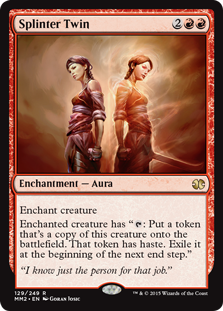
On the other axis we have the synergy within the deck. The combo decks obviously sit at the very top of this axis and the more generic good stuff decks right at the bottom. This gives us far better scope for understanding combo decks and the different guises they can take from the aggro combo decks just trying to do their thing as fast as possible to the more control combo decks like Splinter Twin and Scepter Chant. It also just lets us appreciate more the differences between different kinds of aggro deck etc.
So what exactly do I mean by synergy? All decks should have some but there are differing forms and they need to be a bit clearer for this understanding of archetypes to make sense and be useful. You could argue that a Lightning Bolt has synergy with a Chain Lightning as both work towards the same goal. This is not synergy in this context however. It is cohesion but that is all. The cards are on-theme with each other but beyond that they do not directly make each other better. A Monastery Swiftspear however does have synergy with the Lightning Bolt. Having Bolt makes the Swiftspear better, pretty simple stuff. This is a direct synergy and it is a good one as both cards are good and both cards are on-theme thus having suitable cohesion. It is still a fairly minor synergy however given that some two card combos win the game! Monastery Swiftspear and Soul-Scar Mage again, do not have synergy with each other directly like Chain and Bolt. They do however have an indirect synergy in that they are both supported by the same types of card. Both are empowered by a Lava Dart and so having both allows your other synergy cards to count for more and thus allows your overall list to have a higher synergy rating. This is a fairly minor kind of synergy that red good stuff aggro decks will employ to get a little more bang for their buck for a negligible cost to the build. These synergies are good because of the high stand alone power, good theming and low cost of the cards involved. They are not however powerful in that the combining of these two cards only provides a one off +1/+1 boost to one specific creature! This is a spectrum that includes Voltaic Key and Time Vault which wins the game.
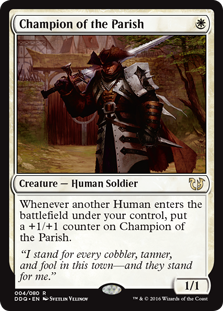
As you go further up the spectrum on synergy on this aggro end of the spectrum you hit things like humans and some other tribal decks. These push synergies a little further to get some very powerful effects. Most tribal decks are actually rather further down the speed spectrum next to midrange decks. I class a lot of the goblins decks these days, certainly the classic looking ones with Ringleader and Matron as midrange decks, just ones high up on the synergy scale. Midrange decks are typically those lowest on the synergy rating and those that are higher up often look most different from the normal expected style. Ramp decks are something that fits more into the midrange higher synergy grouping too, including Tron in modern.
Back to the aggro end and next along as we go up the synergy from tribal lists are things like affinity and Hardened Scales decks. They still operate a lot like aggressive decks but they have much more extreme things they can do as well as a lot of much weaker stand alone cards. Much beyond this point and we are at pure combo decks that are all about speed and run minimal protection and disruption. These are usually a deck with a couple of cards that work together to win the game and then the rest of the deck revolving around finding andplaying those cards. If you have a list which contains card X and card Y that win the game then they have a very high synergy rating between them but they indirectly afford a lot of synergy to cards that can find and play them for you. A Demonic Tutor has no real synergy with a Painters Servant but when you also have a Grindstone in your deck suddenly the synergy level goes nuts as Tutor becomes a high synergy card too.
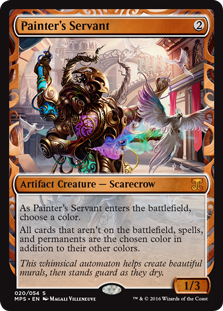
So great, we can plot a deck somewhere in our 2D grid and represent the level of internal synergy it has and the operating speed it has. How is this useful? What can it do for us? I find understanding things and having them in the appropriate context in my understandings allows me to make the best choices. If I just assume a goblin deck is an aggro deck I might play it wrong as a result. I might build it wrong too. Knowing all the consequences of your actions are important. Swapping a few cards around in a build will typically shift it a bit in position on the grid. You might want to go faster to handle the meta better but you might also feel you need to have more potential power as well. This means you need to lower your curve to achieve the first goal but in order to have any chance at getting the latter goal as well you will need to increase the synergy too. This can mean that rather than just playing your best red cards you end up playing things like Thermo-Alchemist. It can mean working in a Champion of the Parish and a Thalia's Leuitenant with sufficient human support in your white weenie deck. This is often worth doing when you know you are facing a deck with something like an Ugin you just have to race but also will have to handle other faster decks that you won't beat if you are just playing Shocks and 2/1 dorks. Everything in magic is a balance and knowing how your changes affect the various scales and where you want those scales set to afford your best chances of winning are important.
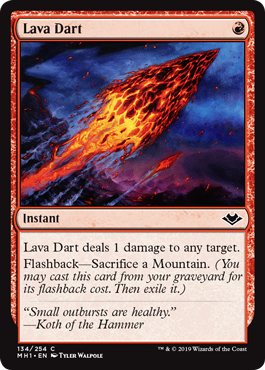
The big key to this is synergy vs power and speed vs power. Most people appreciate speed vs. power very well. Mana curves are now entry level understanding. People are fairly comfortable with getting this balance. What people appreciate less is the trade off between power and synergy. This is because it is much more about the overall deck. The aim is to increase power but it is done by replacing good cards with less good ones which is of course rather counter intuitive. Power per mana is somewhat easy to appreciate when dealing with curve changes. Rating synergy is entirely contextual and cannot be done in any exact sort of scientific way. Sticking with the simple red examples we can get to a place where Lava Dart adds more to a list than Lightning Bolt. Obviously you are never playing the Dart and not the Bolt but there is a critical mass of prowess dorks, Young Pyromancers and Firebrand Archers where the Dart makes the deck more potent than the Bolt overall. Getting good at judging where you maximize your speed, power and synergy is basically the art of deck building. There is sadly no short cut method or magic formula. To get good at it just requires lots of practice. Build a lot of decks, play them, rebuild them but better and appreciate what changes you made and the way in which that should improve the deck.
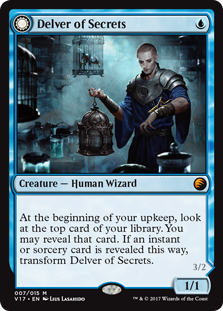
Tempo decks are the final thing I want to discuss as they still don't entirely seem to fit within my model. The best way to do so would be to wrap the speed, or X axis round into a loop. That way between aggro and control but the opposite "side" to midrange we would find the tempo lists. A tempo list tends to have aggro threats and control style answers and interaction. They are faster than midrange decks but have less threats than aggro lists and less interactive stuff than the control decks. They try and win by getting cheap, high value threats into play that they can ride to victory. Traditional control just controls until it can make serious game winning plays. Traditional aggro backs up early aggression with more aggression. Tempo is like a reverse control deck, an aggro start backed up by control rather than more aggression. They ultimately will get out valued, out powered and generally out resourced by all other builds but their tempo element keeps them competitive. They are good because they are proactive but still give you lots of choices and options. You can outplay people and you can force them into using their cards poorly because they are on the back foot. The classic example of a tempo deck is a Devler of Secrets build in Izzet with cards like Thing in the Ice and Young Pyromancer all backed up with cheap removal and counters.
Including tempo decks on our graph as described rather upsets how clean it is as it is no longer a clean simple 2D graph but neither is it a 3D graph. It is just a curving 2D one. You go on direction from aggro to control via midrange or you go via tempo as you track up the "speed" axis clockwise or anticlockwise as it were. Such a graph is nice in that decks will appear at most positions on the graph and nice in that it has relatively few elements to it while containing the important things to appreciate. It is however quite inelegant in a more mathematical sense. What might be an even better way to represent the various core archetypes to bring it more into line with graphs and math is to actually provide a Z axis term. This would be threat density as that is the main difference between tempo and midrange when it comes down to it. They might operate at rather different speeds in game but as far as goldfishing a tempo or midrange deck goes they should be similar. Tempo has quicker threats but way more dead cards in a goldfish and so the greater threat density of the midrange decks will make them tend towards a comparable goldfish speed that is quicker than control and slower than aggro. The only thing I don't like about plotting speed against threat density against synergy is simply that you find lots of areas of your 3D space pretty empty. You do not get many threat light aggro decks for example. Certainly not at the lower synergies. I also don't love giving threat density the same importance as speed or synergy. Certainly threat density is a relevant aspect of a deck but it just doesn't feel as if it is significant as speed or synergy.

Getting too bogged down in a model such as this however is self defeating. This is just a good way to understand the mechanisms and directionality by which you can change decks. It is a tool for aiding understanding and by over complicating it you probably lose some convenience and utility. It is a guide to point you in the right direction. If you want to add a card to a deck you can think of how that card will move the position of your deck on the graph and in doing so which other cards will become less well suited and as such make other changes in an appropriate and informed way. It can help a lot with side boarding, allowing you to cut and add things that better position your list to combat your opponents. It helps a lot with things like cutting Goblin Guide from a lot of the tribal goblins decks that occupy the midrange or combo area at the top of the synergy axis. Goblin Guide is an aggro or tempo card and it doesn't do much to add to midrange or combo strategies beyond the goblin tag. Yes the card is good and yes it is good in a couple of tribal goblin lists, aggro ones and sometimes token go-wide ones too. It is just not an auto include across the board and that becomes far more apparent when you plot decks on a theoretical graph that represents the archetypes. It is no longer a surprise that a premium one drop goblin is getting cut from a goblin deck but more obvious that an aggro card is being cut from a midrange or combo deck.
Another thing this model does well is demonstrate quite how fluid magic is as a game and that decks are. This is obviously a lot more apparent in a singleton limited format than constructed. So much more continuous variance is viable in cube and EDH than in four copies constructed where only isolated pools of things are viable and any halfway house between most tier one decks is a total disaster of a build. For a variety of reasons you can tweak the cards in your decks to nudge your list in any direction you like on the axis. This might be to suitably house more powerful cards or to give you a better chance against the meta or even just to appease a play style. I suspect most people reading this will either think all this is pretty obvious and already intuitively understand these concepts in their own way, or they will not see the point of any of what I am on about. I certainly sympathize with anyone in the latter group. It has been hard to demonstrate exactly why this is useful. All I can do is assure you that if you continue to play the game and gain experience you will at some point find this is just one of those pieces of the jigsaw that slots into place and helps to pad out a fuller understanding of the picture. Taking that metaphor a little further this piece of the puzzle is probably one of those that is just one shade and has no relevant detail on it at all in isolation. They are both some of the trickiest bits to fit in both for jigsaw puzzles and for Magic! None the less, archetypes are a thing but they are not static or singular, they are dynamic and fluid and very much a scale. This is much the same as with almost all things humans try and force into categories so that our words can work better! It is certainly easier to understand 4 simple distinct concepts such as an aggro deck and a control deck than it is to understand the mechanisms that define all these things in a spectrum. It is indeed why I didn't even really consider "tempo" to be an archetype earlier in my magic history as I didn't really appreciate what fundamental elements defined it. It was just a type of midrange deck in my head and with this fudge I likely made a bunch of ill informed choices. So, all this has been simply to say that archetypes are not really distinct things like the colour blue but indeed shades of these things on a spectrum defined by two or more qualities.
Cool blog man, I haven't seen a lot of commentary but I hope you're seeing decent traffic.
ReplyDeleteThanks! No idea what decent traffic would look like for something this niche. I should really post in the cube reddit thing if I wanted more exposure but I know I would wind up dabating (arguing) points with ppl all the time...
DeleteAlways interested in reading about archetypes and tempo. The way I view it is a 3D space with speed and power/synergy on the first 2 axis, on the third I use resilience. A high resilience deck will have more ways to generate card advantage, and have redundant cards to make it harder to disrupt. A low resilience deck will use cards that will set them back to gain a temporary advantage to finish the game. For example Daze and Force of Will to delay the opposing player. Lotus Petal, LED and ritual to get enough mana to win. Even Ancient Tomb and Bitterblossom to use other resources, like life, to get ahead of the opposing player and win before they can catch up.
ReplyDeleteThat is a fascinating way of looking at it. I am going to have to apply this method a bit and see where it takes me. I have just always done it the other way because those are the terms other people tend to use.
Delete